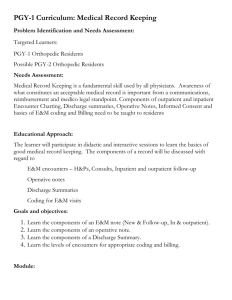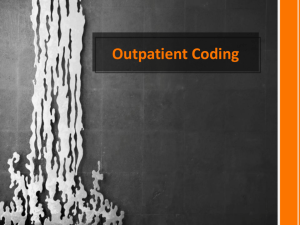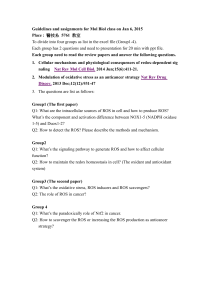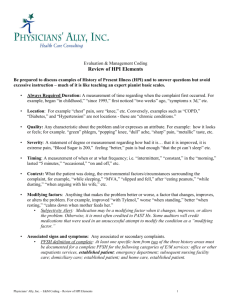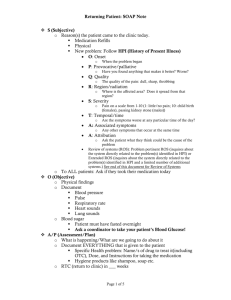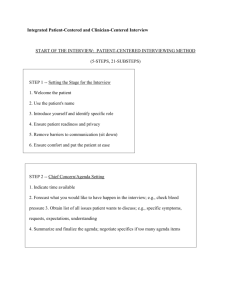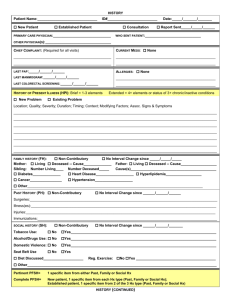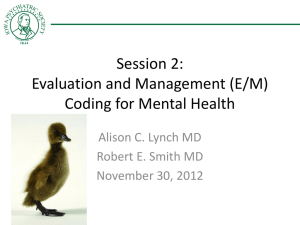Evaluation and Management Coding for Emergency Medicine
advertisement
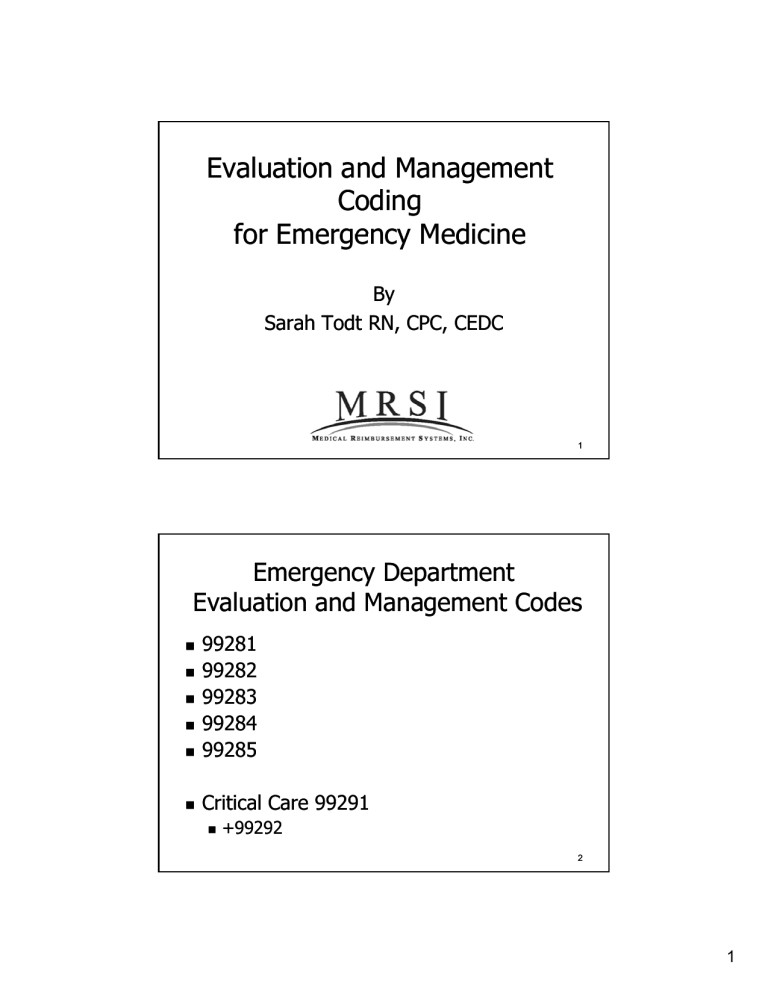
Evaluation and Management Coding for Emergency Medicine By Sarah Todt RN, CPC, CEDC 1 Emergency Department Evaluation and Management Codes 99281 99282 99283 99284 99285 Critical Care 99291 +99292 2 1 ED Evaluation & Management Codes There are three key components that must be met to correctly assign an Evaluation and Management code: History Exam Medical M di l D Decision i i Making M ki 3 CPT E/M Components Other Nature of the presenting problem 99283 vs. 99284 Time Critical Care 4 2 Medical decision making di t t the dictates th highest hi h t level l l code d that can be chosen – Proper documentation s pports your supports o r choice 5 Medical Decision Making 6 3 Levels of Medical Decision Making Straight Forward Low Complexity 99282 Moderate Complexity 99281 99283 and 99284 High Complexity 99285 7 DOCUMENTATION OF MEDICAL DECISION MAKING ■The number of possible diagnoses that must be considered Chest pain patient Diff Dx chest pain: Angina, PTx, PTx, GERD Final Diagnosis GERD The type of management options Rx drug management, IV fluids, parenteral narcotics The amount and/or complexity of information that must be obtained, reviewed, and analyzed Labs, XX-rays, EKGs, Medical records reviewed 8 4 Medical Decision Making Scoring Systems Most use the Marshfield Clinic Type Audit Tool to expand on the Documentation Guidelines Not an official part of the DGs Tool used to score the overall Medical Decision Making E al ates 3 components: Evaluates components Number of Diagnosis and Management Options Amount and Complexity of Data Risk 9 Medical Decision Making: Number of Diagnosis or Management Options C ® does CPT® d not distinguish di i i h between b new and d established patients in the ED New problem no additional Work up Patient seen and discharged New problem with additional Work up Admit, Transfer, OR, …. 10 5 Medical Decision Making: Amount or Complexity of Data Review and/order clinical lab test 1 point Review and/order radiology test 1 point Review and/order medicine test 1 point Discussion of test results with performing physician 1 point Decision to obtain old records and/or history from someone other than the patient 1 point Review and summarization of old records or obtaining history from someone else or discussion of case with another health provider 2 points Independent visualization of image, tracing, or specimen 2 points 11 Risk The third part of the overall Medical decision Making The Risk Table is an official part of CMS Documentation Guidelines Is scored independently Along with Management Options and Amount and C Complexity l i off Data D Highest level of risk in any category determines the overall risk score 12 6 Risk Table Risk of complications and/or Morbidity or Mortality Highest Level In Any Category Prevails 99281 99292 MINIMAL LOW 99283 99284 99285 MODERATE Suture removal OTC med only; Rx management; (placed at other acute uncomplicated Acute illness with facility) injury or illness systemic symptoms; Acute complicated injury; Exacerbation of chronic condition HIGH Abrupt neuro change; Potential life threatening illness; Severe exacerbation of chronic illness; Medications requiring monitoring; i i Parenteral controlled medications 13 Scoring MDM Must Meet 2 out of 3 Mgt. Options p Data Risk ------- 1 pt. Minimal Overall MDM Straight forward ------2 pts. Low Low Complexity New pt/ no 3 pts. Moderate Moderate Add’l w/u Complexity New pt 4 pts. High High with add’l Complexity w/u ED E/M Supported 99281 99282 99283 and 99284 99285 14 7 CPT® Specific Rules 15 Nature of The Presenting Problem 16 8 Nature of Presenting Problem 99281 Usually, the presenting problem(s) bl ( ) are self lf limited li it d or minor i 99282 Usually, the presenting problem(s) are of low to moderate severity 99283 Usually, the presenting problem(s) are of moderate severity 17 Nature of Presenting Problem 99284 Usually, the presenting problem(s) are of high severity, and require urgent evaluation by the physician but do not pose an immediate significant threat to life or physiologic function. 99285 Usually, the presenting problem(s) are of high severity and pose an immediate significant threat to life of physiologic function. 18 9 Level III: General comments Moderate presenting problem but not requiring urgent evaluation Prescription Drug Management Includes Rx meds given in ED Eye drops, ear drops, Antibiotics, pain meds Limited diagnostic studies Single XX-ray 19 Level III: General comments Systemic symptoms Viral illness Mild exacerbation of chronic condition Recurrent condition 20 10 Level IV: General Comments Urgent Tx of condition Multiple diagnostic studies Special studies alone (CT, MRI,US) ED Interventions: Nebs Parenteral medications Usually not admitted 21 Level V: General Comments Many Admissions Frequently Involve: Prolonged services in ED Special Studies with other tests tests--(CT/MRI/US) Multiple reassessments Interpretations of EKG or xx-rays Old record review Documented conversations 22 11 HISTORY 23 History The history portion of a patient patient’ss chart includes some or all of the following elements: Chief complaint (CC) History y of p present illness (HPI) ( ) Review of systems (ROS) Past, family and/or social history (PFS) 24 12 History of Present Illness Location-left sided chest pain, upper, lower, Locationposterior Context –while shoveling snow, while cutting a roll, during the football game, scratched by the cat Q lit –sharp Quality h chest h t pain, i throbbing th bbi headache, crampy belly pain Timing – worse at night, daily, constant, frequent 25 History of Present Illness Severity –moderate chest pain pain, 6 out of 10 Duration--10 minutes, for a week Duration Modifying Factors– Factors–worse with exertion, unrelieved by Tylenol Associated Signs and SymptomsSymptomsdiaphoresis, fever, vomiting 26 13 History of Present Illness HPI flushes out the chief complaint in greater t d detail t il There are two types of HPI identified for the purpose of coding A brief HPI consists of 1-3 elements (99281--99283) (99281 An extended HPI consists of at least 4 elements (99284 (99284--99285) 27 HPI Examples: Brief-- 32 year old male with left shoulder Brief injury, occurred 4 hours ago Extended-45 year old female with left Extendedsided, sharp chest pain for 30 minutes with left arm numbness and diaphoresis. The pain is worse with exertion 28 14 HPI Examples Multiple Modifying Elements Child with Chief Complaint of fever: 4 hours of fever, with moderate vomiting, vomiting, diaphoresis that is worse at night, night, right lower quadrant abdominal pain pain,, unrelieved by Tylenol 29 Review of Systems (ROS) An inventory of body systems “Patient’s positive responses and pertinent negatives should be documented” “For the remaining systems, a notation indicating all other systems are negative is permissible” CMS 1995 Documentation Guidelines 30 15 Review of Systems (14) Allergic/Immunologic Cardiovascular Constitutional Symptoms Ears, Nose, Mouth, Throat Endocrine Eye Gastrointestinal Genitourinary Hematologic/Lymph. g / y p Integumentary Musculoskeletal Neurological Psychiatric Respiratory 31 Review of Systems (ROS) Ap problem p pertinent ROS addresses 1 system (99282/99283) An extended ROS addresses 22-9 body systems (99284) A complete ROS addresses at least 10 organ systems (99285) 32 16 Past, Family, Social History (PFS) Past History - A review of the patient's past experiences with illnesses, injuries, treatments treatments,, past hospitalizations, surgeries, medications, allergies, immunizations Family History - A review of medical events in the patient's family with regard to chronic illness, cause of death or diseases related to the current compaint death, Social History - An age appropriate review of past and current activities such as drug and alcohol use, living situation, and job history 33 Past, Family, Social History (PFS) There are two types of PFS in emergency department coding. coding A pertinent PFS consists of any 1 element from the PFS (99281(9928199284) A complete l t PFS consists i t off one element from 2 of the 3 PFS history areas for ED E/M codes (99285) 34 17 History Issues ROS and PFSH may be recorded by others The provider must reference the elements ROS not as easy to obtain from NNs No need to record things in more than one place ROS elements may be documented in the HPI Chest pain associated with nausea and vomiting A chief complaint will generally include at least one ROS HPI element for associated signs/ signs/sxs sxs GI ROS element Same statement may not satisfy multiple sub sub--elements of HPI or ROS Chest pain since this morning can not be both timing and duration 35 THE “EMERGENCY MEDICINE” CAVEAT “If the physician is unable to obtain a history from the patient or other source source, the record should describe the patient’s condition or other circumstances which precludes obtaining a history.” CMS 1995 Documentation Guidelines 36 18 CMS History Caveat Documentation must include the reason history is not obtained NH patient with dementia Postictal Severe dyspnea (CHF or Asthma) 37 Exam 38 19 1995 Guidelines for Physical Exam To determin determine e the extent of an examination CPT recognizes the following 11 organ systems:: systems Eyes -Psychiatric Cardiovascular -Respiratory Gastrointestinal -Genitourinary Musculoskeletal -Skin Neurologic Hematologic/Lymphatic/Immunologic Ears, Nose, Mouth and Throat (CMS recognizes constitutional) 39 1995 Documentation Guidelines 7 Body Areas Head-including face HeadNeck Chest--including breast and axillae Chest Abdomen Back including spine Genitalia, groin, buttocks Each extremity 40 20 1995 Guidelines for Physical Exam Problem FocusedFocused-1 Body System including affected area (99281) Expanded Problem Focused - a limited examination of the affected body area or organ system and related body area(s) or organ system(s) 2-4 Body systems including affected area (99282/99283) 41 1995 Guidelines for Physical Exam Detailed - an extended examination of the affected body area(s) or organ system(s) and any other symptomatic or related body area(s) or organ system(s) 5-7 Body areas or systems including affected area (99284) Comprehensive - a general multimulti-system examination 8 or more organ systems including affected area (99285) 42 21 Documentation Guidelines Physical Exam Exam--Record Format Checklists to indicate performance of any item ok □ Lungs CTAB Brief statement or notation “negative” or “normal” ok for normal findings ENTENT-normal Specific abnormal and clinically relevant negative must be documenteddocumented- “abnormal” without elaboration insufficient Abdomen soft, tender RLQ, BS poor 43 Common Documentation E/M Down Codes for Medicare records HPI-need 4 HPI elements for 99285 HPI With 3 or less go down to 99283 ROS-need 10 ROS for level 99285 ROS If 2 2--10 go down to 99284 Ph i l ExamPhysical Exam E -need d 8 systems t ffor 99285 If <8 go down to 99284 Past/Family/Social-- need 2 for 99285 Past/Family/Social If just one go down to 99284 44 22 99285 Acuity Caveat 99285 ED visit for the evaluation and management of a patient, which requires these three key components within the constraints imposed by the urgency of the patient's patient s clinical condition and/or mental status Severe Dyspnea - COPD, Asthma Pneumonia Unstable Vital SignsSigns- Trauma, Sepsis Severe Pain - Long bone fractures, fractures open fractures CPR/ CPR/intubated intubated Should state on chart: Hx/Exam limited by____ 45 Documentation Guidelines HPI ROS PFSH Exam Level of Service 1 0 0 1 99281 1 1 0 2 99282 1 1 0 2 99283 4 2 1 5 99284 4 10 2 8 99285 46 23 2010 RVUs 47 Critical Care 48 24 Critical Care Overview Evaluation and Management (E/M) Code Found in first section of CPT® Reported using 99291 Additional work reported with the add on code +99292 49 Critical Care Overview Unlike other E/M codes no specific key element requirements History, Physical Exam, Medical Decision Making No Specific HPI, ROS, Physical Exam documentation requirements Time based code Patient must meet certain clinical criteria 50 25 Critical Care Definition “A critical illness or injury acutely impairs one or more vital organ systems such that there is a high probability of imminent or life threatening deterioration in the patient's condition..” condition.. (AMA/CPT 2008) 51 Organ System Failure Central nervous system failure Acute MI Severe trauma Renal failure Encephalopathy Coagulopathy Metabolic failure Shock Hepatic Failure Stroke Circulatory failure Toxic Ingestion (methanol) Severe Acidosis Respiratory p y Failure Pneumonia New onset Hyperkalemia 52 26 Critical Care Requirements Clinical Requirement of high probability of deterioration Time requirement Minimum 30 minutes Excludes separate procedures 53 “Full Attention And Physician Time” Time counted must be exclusively devoted to patient Does not have to be continuous Physician must document total time on chart Must document that time involved in separately billable procedures p oced es was as not counted co nted toward to a d CC time Attestation with check box or fill in the blank OK 54 27 Critical Care Time What Counts? Bedside patient care Reviewing ancillary studies Discussions with: Family, rescue, nursing, physicians as related to care Ch t documentation Chart d t ti and d completion l ti Bundled Procedures CXR 55 Critical Care Bundled Services Cardiac C di Output O t t Computer Data 99090 94002-94004, 94660, 9400294662 Vascular Access 92953 Ventilator Mgt. 94760/61/62 71010/71015/71020 Pulse Oximetry Transcut.. Pacing Transcut 93561/93562 CXR 36000/36410/15/40 36600 Gastric Intubation 43752/91105 56 28 Critical Care: “What is not included?” Endotracheal intubation 31500 CPR 92950 (time must be subtracted) Triple Lumen Catheter insertion 36556 Transvenous pacer 92953 EKG interpretation 93010 Bill these separately 57 Critical Care Time Requirements Critical Care Time Code <30 minutes Approp. E/M code 30--74 30 99291 75--104 75 99291, 99292 105--134 105 99291, 99292 X 2 58 29 Clinical Conditions Consistent with Critical Care (1) Severely l altered l d mentall status Cardiac or respiratory arrests Airway compromise Need for immediate surgery Trauma Ruptured ectopic Perforated Viscous AAA 59 May Not Qualify For Critical Care Admission to Critical Care services secondary to no other bed in hospital Tele Borders Hospital Specific Rules such as: nebs Q 2 hours in otherwise stable patients 60 30 Critical Care: Other Facts “All All other billable procedures not included in CC time” Requires 30 to 74 minutes for first hour of CC Frequently feedback 61 Teaching Physicians Critical Care Resident time does not count TP personal time must be clearly documented Teaching time does not count Subtract time for separately billable procedures 62 31 Critical Care and CPR Critical reporting requires subtracting minutes spent performing separately billable procedures 92950 CPR is not a bundled service should be reported separately Must subtract out amount of time spent supervising CPR 63 QUESTIONS? 64 32 Thank you Sarah Todt RN, CPC, CEDC stodt@mrsiinc.com www.mrsiinc.com 65 33

